September 2006 Newsletter
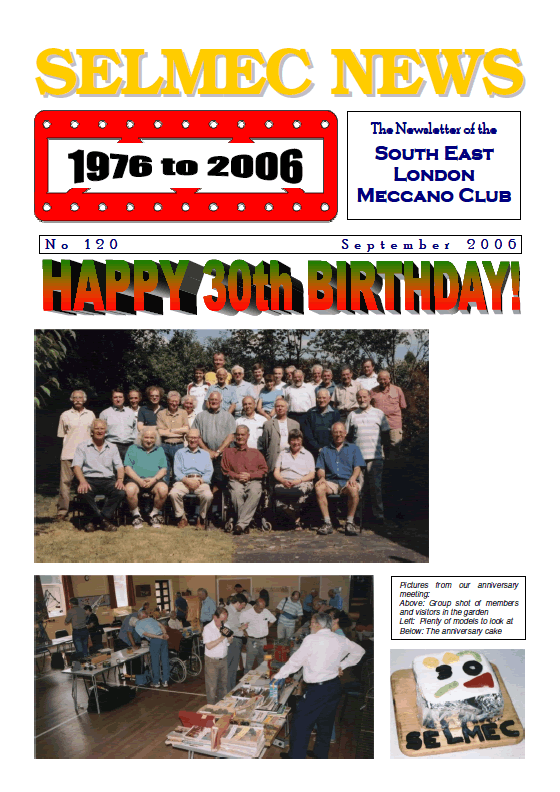
September 2006 Newsletter
Issue 120
This was one of our informal quarterly meetings where our members showed off their latest Meccano creations.
At around 2:00pm we had a short committee meeting, followed by the Model Tour in which members were invited to give a short talk about their models — in particular their entries for the Secretary’s Challenge!
Written by Chris Warrell
Preface
Some of you may remember that I published a history of the club ten years ago (in the August 1996 newsletter). I thought that this was a good time for an update — plenty of things have happened in the last decade, and new members might like to read it.
Introduction
In June 2006 SELMEC celebrated its thirtieth birthday (it was the closest we could get!) with a special meeting. Back in 1976, on 24th July, our inaugural meeting was held in my parents’ house and eight people were present, some of whom are still members today.
Apart from myself, we still have Peter Clay, Geoff Davison, Adrian Ashford and Ike Ascher. A copy of the meeting report, (retyped from the October 1976 Meccano Magazine Quarterly (MMQ)) is reproduced below. (It seems that I made a mistake all those years ago and incorrectly referred to Adrian’s loco as a 4–6–0, when it should have been 4–6–4 — and for three decades he thought that MMQ had made the error!)
SOUTH EAST LONDON MECCANO CLUB
The response to my announcement in the January issue was a bit slow at first, but soon picked up and I set the date of the first meeting for 24th July at my home.
Geoff Davison showed us a Tower Crane built from instructions in the Crane Multikit, which he has improved by using 12½” instead of 9½” Braced Girders. Adrian Ashford brought along a half-finished model of a 4–6–0 Steam Locomotive. Powered by a Motor-with-Gearbox which operates all the complicated linkages, it will weigh in excess of 19lbs, and will therefore be a stationary model, the wheels just clearing the rails when completed.
Peter Clay showed a very unusual model in the shape of a Lorry-mounted Excavator, both sections of the model being based on standard Meccano outfit models. The Lorry was powered by a Motor-with-Gearbox, whilst all the movements of the Excavator were powered by a Junior Power Drive Motor via a compact gearbox.
Stan Bedford brought along a model of a 0–4–0 Locomotive and tender and also a model of the Ship described in the April 1975 MMQ. The latter was built in an attempt to interest his grandson in the Meccano hobby! Stan’s other grandson, Neil, showed a freelance model of a Steam Excavator built from a № 9 Set.
I, myself, showed a remote-controlled Centurion Tank which runs on plastic tracks. It is powered by two Motors-with-Gearbox, one driving each track, and con-trolled by two 4-way switches for two forward and reverse speeds.
Also present at the meeting were Ike Ascher and Steven Ripper, and it has been decided that the next meeting will be in October.
Christopher Warrell
Plans for the first meeting started long before the first meeting however. In December 1975 I wrote to the MMQ suggesting the idea for a club in south east London and they duly placed an announcement in the January 1976 edition.
In February I received four letters all written on the 18th: both Adrian and Ike expressed their support for the proposed club; Dennis Higginson of Stevenage Meccano Club sent words of encouragement. I didn’t get quite the same response from Frank Palin, then secretary of Holy Trinity Meccano Club. He didn’t see a need for another club so nearby and thought I should join his instead! I actually did both, attending my first HTMC meeting before the first SELMEC one — but at least I got to see some of my potential new members!
Early Years
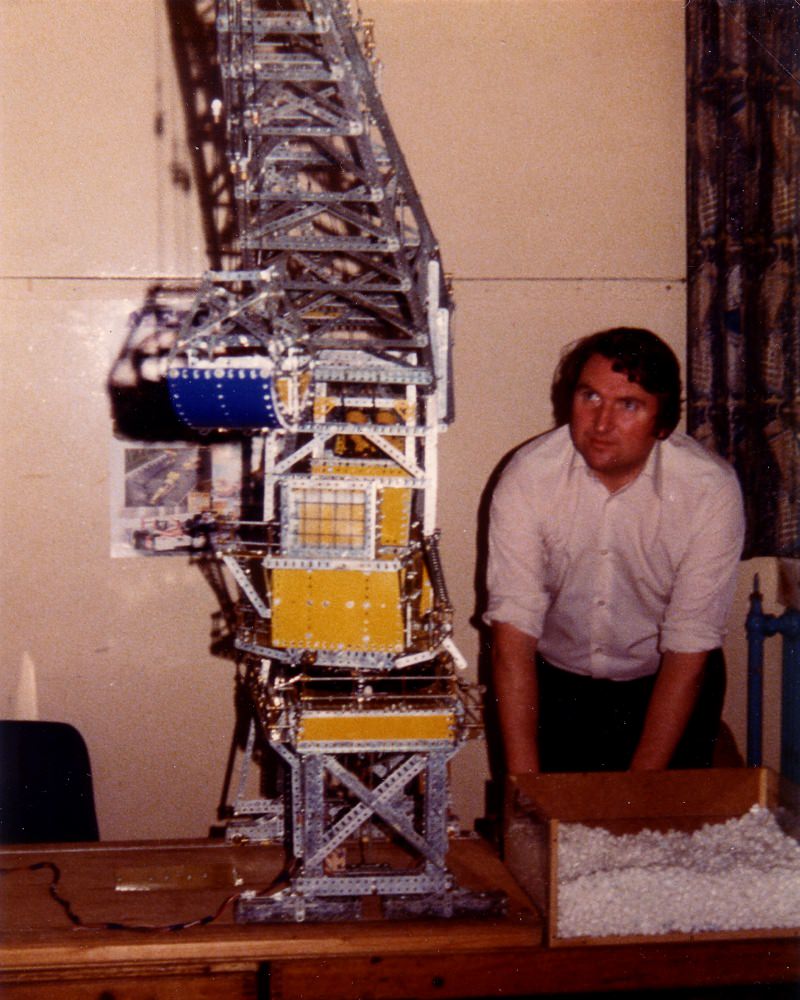
Eddie Oatley with his level luffing grab crane at our first exhibition on 29th September 1979
Our second and third meetings were held in St. Luke’s Church Hall, Eltham — not in the main hall where we would later meet, but in a small upstairs room. The third meeting was rather cramped so, from the next meeting, we moved to the Salvation Army Hall in Welling at the suggestion of Stan Bedford, where we remained until 9th April 1983. During our time at Welling Stan’s wife, Ivy, provided the afternoon refreshments.
Within a couple of years we were well established with a membership of a dozen or so and with a high turnout of members to each meeting.
The Meetings
The pattern of meetings was established early on with four being held every year, and membership gradually built up to 54 members by 1985, eleven of whom were juniors. (Currently we have around 50 members three of whom are juniors — although we only see one of them regularly).
The general format of the meetings has never really changed except for the model tour. At the first two or three meetings there was no formal structure — things just happened! After this we had a walkabout model tour.
As the attendance at meetings grew this became a bit unwieldy at times with the problems of people talking for too long and others falling by the wayside and having their own conversations. Around 1987 we introduced the seated talks which largely solved the problem.
From 1981 to 1988 Bert Love of the Society of Advanced Model Constructors (based in Birmingham) was a regular attendee. He would fill us in on the then current Meccano situation — the Binns Road factory had had a workers’ occupation in 1979/80 and subsequent closure so there was plenty to talk about!
He also sponsored a Junior Model Building Competition — we had ten or twelve eligible members — and the winner each time receiving a Meccano prize from Bert.
Bert was never an official member of the club, but he was subsequently made an honorary member as a token in recognition of the support he had given SELMEC over the years. He and his wife moved to Isle of Bute in Scotland, but he still kept in touch until his death in 1999.
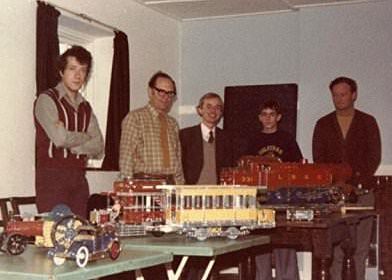
Peter Clay, Geoff Davison, Adrian Ashford, Richard Greenshields and Charles Yearsley at our second meeting on 16th October 1976
With the membership expanding after the first few years, the hall at Welling was sometimes bulging at the seams. When Stan and his wife left the area for Bognor Regis in 1983, we had to look for another hall and here was our chance to find a bigger venue. Shrewsbury House, at the top of Shooters Hill, was tried out for one meeting, but, being too small, we then did the logical thing and moved to the same venue we’d used for the exhibitions — Sherard Hall in Eltham.
We remained there for a number of years, but the costs had gradually risen, and so in 1991 we moved to St Luke’s Church Hall in Eltham. This reduced our costs considerably, although there was a lack of car parking and a flight of stairs to the front door to contend with! Thirteen years later we discovered that the Sherard Hall had brought their fees down (or had all the others gone up?) so a move back to our present venue was signalled in January 2004. Here, not only do we have a level access and parking in the grounds, but a caretaker who puts up all the tables and chairs for us — and then clears them away again at the ends of the meeting!
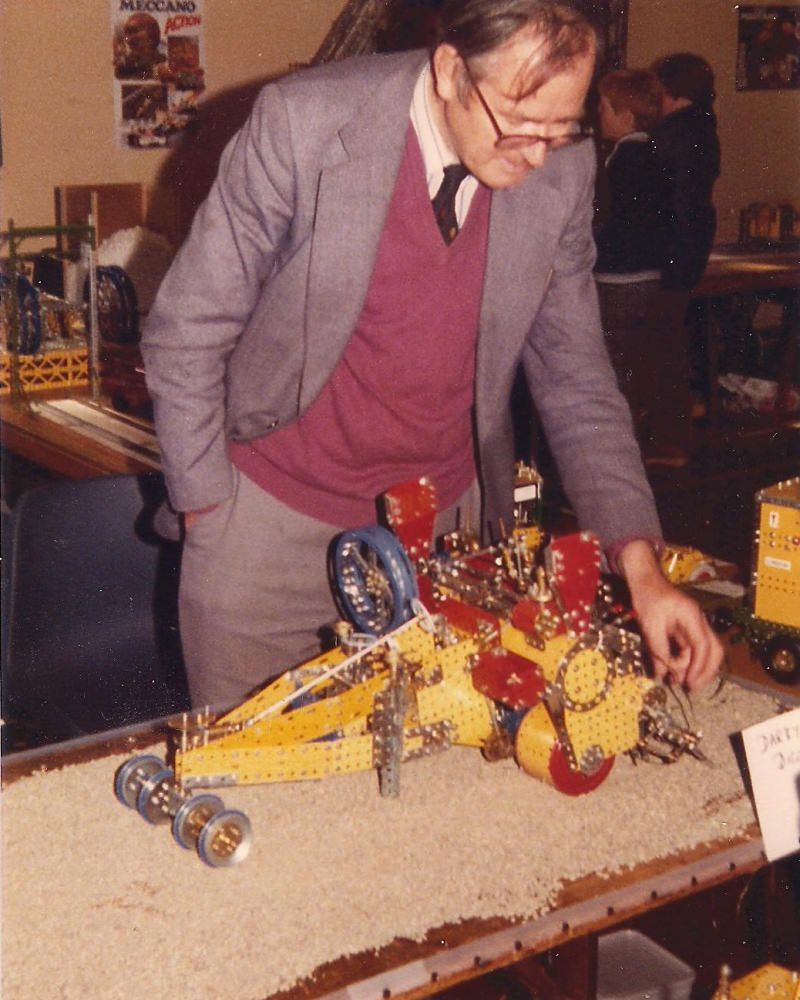
David Whitmore and his Darby-Savage digging machine also at our first exhibition
First Exhibition
At the meeting in February 1979 we made arrangements for our first public exhibition, some of us having seen a successful one by the Solent Meccano Club.
We had about 16 members at the time and we had already had some exhibition experience having had a stand at the Memorial Hospital Fete the previous summer. Technically that was our first public exhibition, but we were merely a part of a much larger show, with only two or three tables for ourselves. There were also no financial liabilities, whereas the event we were planning would have to be funded entirely from within the club: if attendance was poor we could have lost a lot of money.
It was thought that the meeting venue would be too small for such an event and so the Sherard Hall was recommended as a suitable place — it was near Eltham High Street and would hopefully attract a lot of visitors. It was also important to ensure that a large number of models were on display. We decided to hold the exhibition in the autumn to capitalise on the one at Henley, the idea being that many members would have built models for that show.
It worked! The exhibition, held on 29th September 1979, exceeded all our expectations: all our members turned up with models along with a number of modellers from other clubs. Of the 366 visitors who paid the sum of 20p or 10p for entry fifteen decided to join the club that day, almost doubling our membership in an instant!
Officers of the Club
The organisation of the club has always been free and easy with no long list of rules (there isn’t even a short one!) or constitution to tie us down. However, in 1980, it was decided to elect some officers; up to that point I was, by default, Club Secretary, but there was no one else to share the burden — or blame — of running the club, although Geoff Davison had been acting as unofficial Chairman for some time by then.
At the meeting of 12th April 1980 Adrian Ashford was elected as President; Geoff Davison, Chairman and myself as Secretary/Treasurer and meeting organiser. This was maintained for a few years with the incumbents being re-elected en bloc as a matter of course each year.
Adrian gave up the role in 1985 because he thought he was not producing sufficient original Meccano models worthy of a president! (But those he did produce most certainly were worthy). Geoff remained as Chairman until January 2002 when Frank Paine took over.
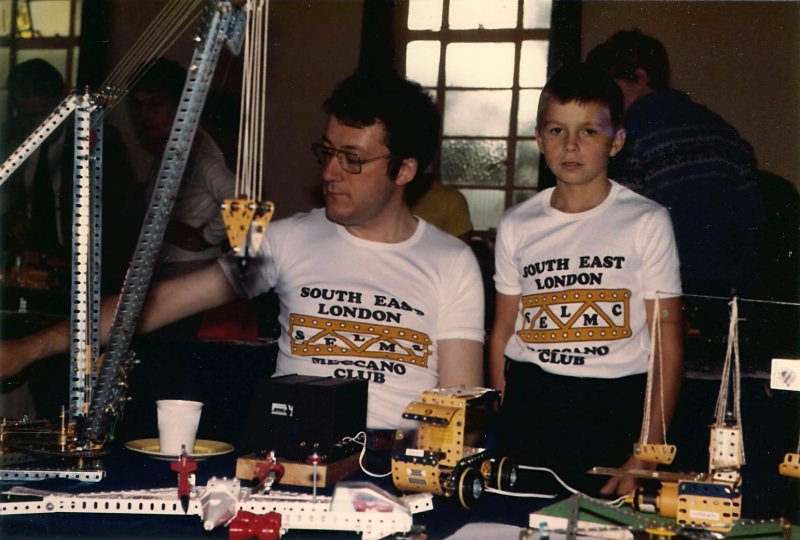
Peter Clay and Roy Thompson model our very trendy T-shirts at our second exhibition on 27th September 1980
The post of Secretary has had a few incumbents: yours truly was Secretary/Treasurer until 1986 when a new Secretarial Committee was formed. It consisted of Frank Pycroft as its head, assisted by Robin Lake (model reports, correspondence) with Keith Patey as Treasurer. I was retained to arrange the annual Meccano Model Exhibition.
Unfortunately Frank left for pastures new in mid 1987 so Peter Clay stepped in, other personnel remaining as before.
This arrangement carried on until January 1992 when I resumed Secretary’s duties. Peter Clay moved to Treasurer and Adrian Ashford took on the job of Exhibition Organiser. (The idea of a Secretarial Committee had been dropped by then). Adrian was succeeded by Nigel Pope in 1997.
More changes came about in 2000 when I decided that I would have to give the job of Secretary to someone else. Geoff Carter stepped into the breach and I resumed Exhibition duties.
In 2001 Geoff Davison had announced that this would be his last year as Chairman, a role he had held since the start of the club. The following January Frank Paine took over.
The current line up was established in January 2004, when Geoff Carter retired for health reasons, although he’s still very active model-wise.
More Exhibitions
After the success of the first exhibition in 1979 we decided to hold another one the following year. This too was very successful but with a slightly lower attendance. However, we still made a tidy sum on all the early exhibitions, mainly due to the catering; we did our own refreshments for all the exhibitions at Sherard Hall (from 1979 to 1990) and a fair profit was made each time. Various wives, mothers, sisters and friends helped prepare and serve the food and drink to the public and exhibitors. The team was led by Jean Warrell and Ivy Bedford with, in various years, Joyce Ashford, Angela Crowell, Vi Palin, Win Parker, Cathy Warrell and Rosemary Warrell.
The attendances had fluctuated around 300/350, but 1983 and 1984 were particularly good with 480 and 523 visitors respectively, mainly due to the free plug on ITV’s Six O’clock Show and some good coverage in the local press.
In 1989 and 1990 (the last two exhibitions to be held at Sherard Hall for a few years) we moved the event to the springtime. With increased costs of hiring the hall we decided to look elsewhere for premises (this applied to the meetings as well).
1991 saw a return to autumn and the Citizens Gallery in Woolwich for the first time. This proved to be far from satisfactory: we had very few members exhibiting, down to 300 visitors and the hassle and expense of hiring tables for the event since the gallery had very few of its own were just some of the problems. We lost a lot of money on that one!
In 1992 we moved to the Christ Church hall, Shooters Hill. This was a much smaller venue than the previous two, but with a financially attractive ‘profit sharing’ method of paying for the hall. Attendance by the public fluctuated between about 250 and 350; exact numbers are not known since the introduction of the family ticket.
A few years later the church started to charge us a fee for the hall and, since Nigel Pope had previously offered us the use of the Scout Hall in Bromley, we took up his offer from 1997. The remoteness of the hall from the centre of Bromley meant carefully placed signing to guide visitors to the exhibition. We attracted around 200 people who had a large array of models to look at, as well as four dealers to visit, despite the small size of the venue. The scouts provided the refreshments.
Things turned full circle in 2004 when we decided to return to the Sherard Hall for that year’s exhibition. It was thought that we ought to be able to fill the larger hall — and make a profit on the door, instead of giving all the money away! We did make some money, although attendances were now down to around 150. There was a slight lull in 2005, but numbers were back to over 160 in our anniversary year of 2006.
Despite the ups and downs, we have had a Meccano Model Exhibition every year since 1979, which has kept the club in the public eye and generated a number of new members over the years. It’s also a good, and exhausting, way of spending a Saturday!
Other Events
During the first decade of the club we engaged in some ‘extra curricular’ activities: one of these was the Memorial Hospital Fete in Shooters Hill, and on 30th July 1978 we had our first display of models there. This was a Sunday afternoon event organised by the League of Friends every summer. Seven members turned up — in the rain — with a variety of models, none of which could be powered from the mains due to the fact that we were in the middle of a field! Whether the rain stopped later I’m not sure, but we had some interest from the public, with one or two wanting to join. We had a stall there every year until 1985.
We also had a couple of window displays in branches of the Britannia Building Society. This came about because someone at their Chislehurst branch had been impressed by our third exhibition. Models from nine club members were displayed in their window for four weeks in March 1982. Most of these were static, but a couple of models that could operate unattended — a windmill and a clock — were powered, the former through a time switch to avoid overheating.
This proved very popular with visitors to the branch, as well as the Welling office of the Britannia: we had a model display there for four weeks in June of the same year. Word got around because we also had interest from the Walworth branch at around the same time, but nothing came of it in the end.
In the autumn of 1984 we had a display in the window of the Halifax Building Society in Eltham High Street. This was done as an advert for the exhibition of that year. You couldn’t do that now — none of their windows are suitable.
Another regular event that SELMEC was actively involved in was the biennial Meccano exhibition at the London Transport Museum in Covent Garden. The first of these was for a week in the Christmas/New Year season in 1983/4. The models were there throughout the week, but the WLMS and ourselves shared the responsibility of manning the event. In that first year we also had a visit from the BBC who filmed a piece for their Breakfast Time TV programme.
The show, which was organised by Michael Edwards of Brighton, occupied the same slot in the Meccano calendar for a few years.
SELMEC Publications
There has been mainly just one publication of the club, and that is the quarterly newsletter. Early editions were not sent to members, but were for publication by MMQ in its regular club feature, and were, by necessity, short.
From the sixth meeting reports were sent to members as well as MMQ, and these were about two pages long, typed without any fancy titles or logo. By the early 80s the reports had expanded, and some of these could be four or five pages in length, depending upon the news, which often included details of the Meccano situation courtesy of Bert Love who regularly sent out a newsletter.
During Frank Pycroft’s tenure as Secretary the reports were typed on a word processor. It also saw the introduction of the SELMEC Modeller, a four page publication with modelling ideas, mechanics, etc. edited by the late Robin Lake. Two editions were issued (free to members), one each in 1986 and 1987.
A return to a good old manual typewriter was necessitated when Peter Clay took over. At the beginning of 1992 the current style of newsletter, with a new name, was introduced.
Our first regular colour newsletters appeared in Geoff Carter’s tenure, these being produced on his own ink jet printer — the only previous occasion being the 20th anniversary in 1996 when we had a photocopied colour front page. This period also saw members receiving their SELMEC News by email for the first time.
When I resumed as Secretary the colour disappeared, the publication being photocopied and stapled by a local firm, the exception being the 30th anniversary edition which had two pages in colour. Email versions were still sent to those members who requested it, and these are still in colour!
Secretary’s Challenges
In 2001 our then Secretary, Geoff Carter, was disappointed by the lack of models appearing at meetings, despite the good attendance record of members. To try and remedy this he thought he’d set a model building challenge at every meeting.
The first Secretary’s Challenge was to get out your oldest set manual and make a model from it, as close as possible to the instructions. Nine or ten members took up the challenge and brought their models to the June 2001 meeting. The next one was to build a model powered by a magic motor and this produced some twelve entries from eight members.
Other Challenges set by Geoff were: walking model; a model with a use outside Meccano; a model using parts for which they were not designed; a micro model; a model from a specific list of parts (adopted by the New Zealand Federation of Meccanomen for their own challenge in 2004); a model using a ring of the same part; a model using 1” pulleys; smallest powered model; Christmas model; and a model using card parts.
Not all the Challenges produced a huge number of entries, but when I took over the reins in 2004 it seemed sensible to carry on to see how it went. My first one was borrowed from the Henley exhibition — no nuts and bolts. After that we have had: a model using one part only; a measuring device; a model using curved or circular parts; a landmark building; a model using the hinged flat plate (producing a record thirteen entries); four anniversary challenges — the big 3–0; Pocket Meccano model; 1976 manual model; and Crane Building Kit model.
The challenges have produced an amazing variety of models over the last five years; a lot of members make a point of trying to come up with a new model for each one, so the original aim has worked pretty well.
www.selmec.org.uk
Sometime around the summer of 2001 we joined the modern age by having our own website. This was set up by Tim Surtell, one of our younger members, who had gained a BEng (Hons) Electrical and Electronic Engineering at the University of Greenwich. The website has been gradually built up to include mug shots of most of the members, photographs and descriptions of models and articles from SELMEC News.
Initially the website was set up so that only Tim could access the site and upload information. In 2006 the site was completely rebuilt and now anyone can log on and make alterations to photos and descriptions of their models.
The site also includes details of meeting and exhibition dates, and general information about the club. It also has links to other Meccano websites.
The most useful aspect about the website is that people across the whole world can easily see when our meetings and exhibitions are held: as a result we’ve had visitors from Australia and various enquiries from interested parties completely out of the blue!
Looking Back
In the first seven years we had been located in venues of ever increasing size to accommodate the expanding membership; my parents’ house; the small room in St. Luke’s; Salvation Army Hall; Shrewsbury House (one meeting), the Sherard Hall in 1983, St. Luke’s church hall and back to the Sherard Hall.
The first decade saw more diverse activities than currently: a stand at the annual Woolwich Memorial Hospital fete and various building society displays.
We have also supported other Meccano exhibitions over the years, such as Henley and Kew Bridge and those of individual clubs.
The change in exhibition venue in 1991 coincided with the change in meeting hall as well. The meeting venue was fairly constant while the location for the exhibition moved around for a few years. We moved back to our present location, the Sherard Hall in 2004 for both meetings and the annual exhibition to find a much improved venue with level access and a very helpful caretaker as well!
The Future
The membership is maintained at a steady 50 or so: We get a good turnout to most of our meetings and attendance at our exhibitions has been very high. It all bodes well for the future. Keep building those models!